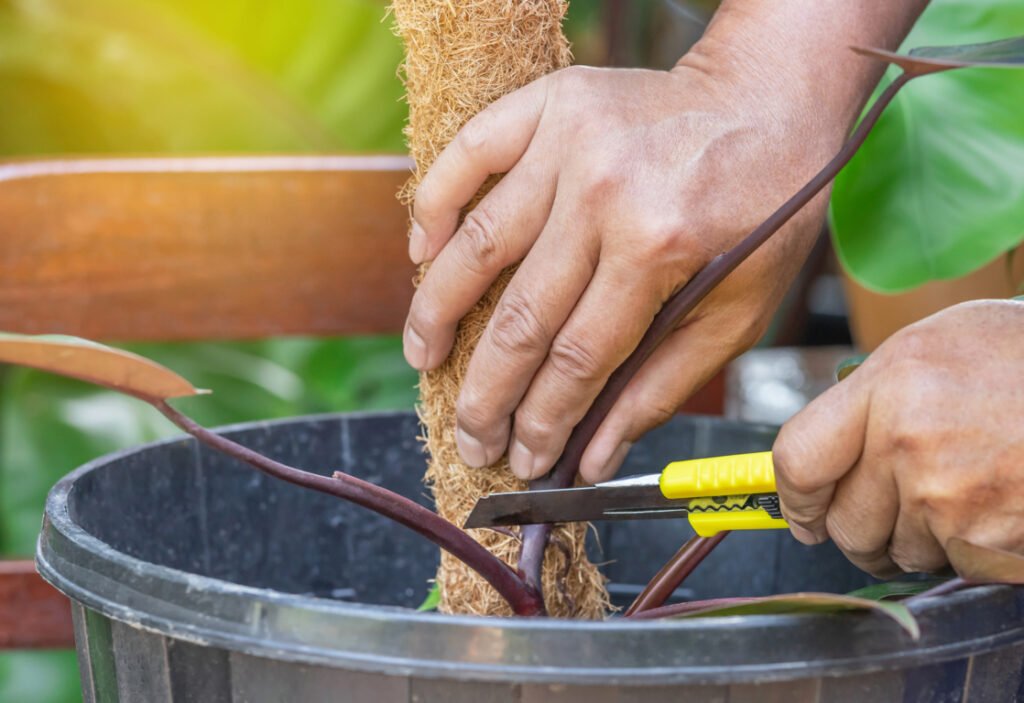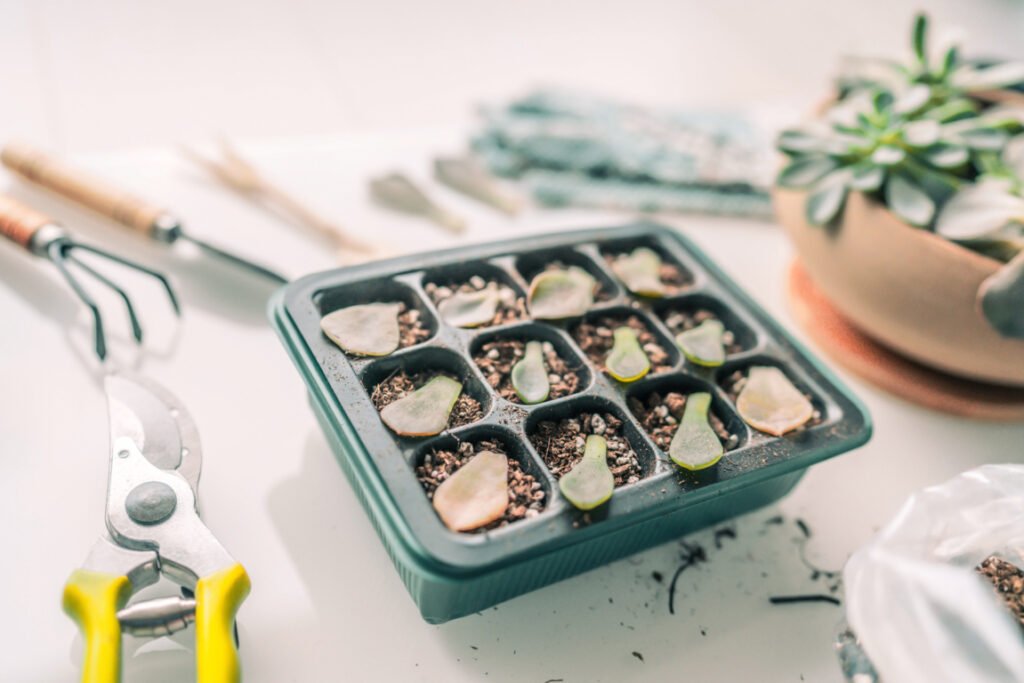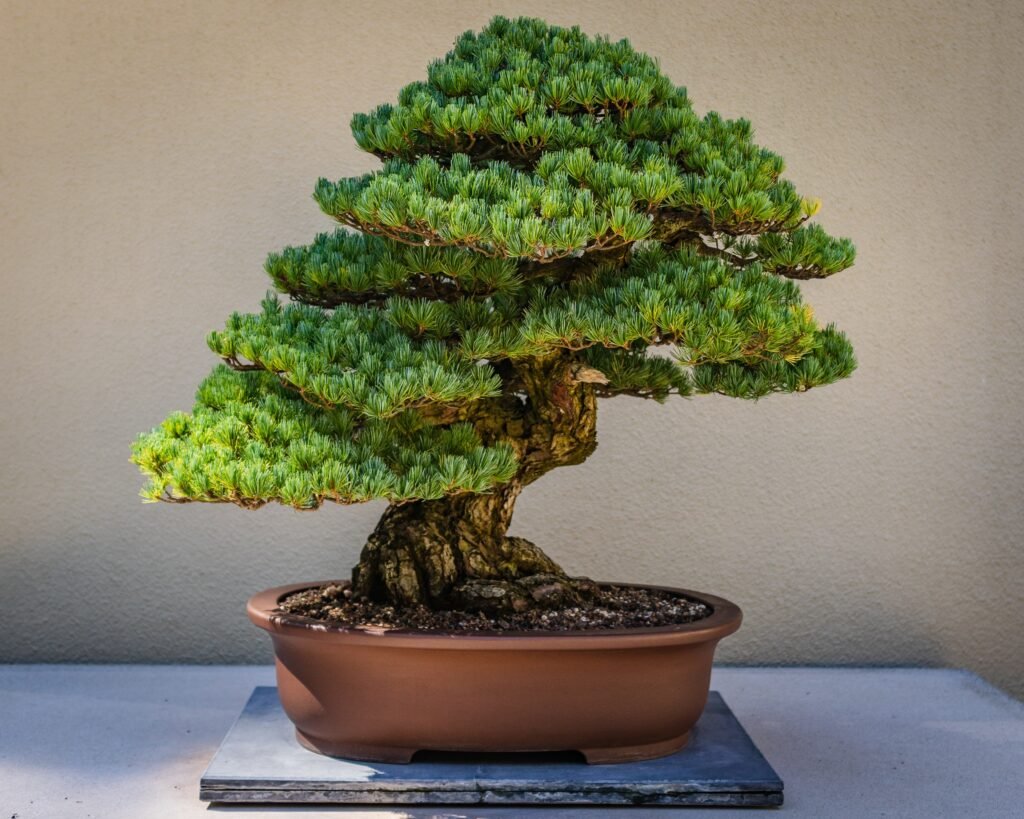
A tree philodendron with its beautiful cascading foliage can be a stunning addition to any home and garden. They thrive in our homes, needing little care and attention. What if you could double the fun and have multiple philodendrons in your home?
Tree philodendron propagation is the process of creating new tree philodendron plants from an existing plant, and it’s a relatively easy process that anyone can do with just a few materials and some guidance.
If you wish to learn more then keep on reading.
First, let’s learn about the plant itself.
Tree Philodendron
| Common Names | Lacy Tree, Philodendron Selloum, Tree Philodendron |
| Botanical name | Philodendron Bipinnatifidum |
| Suitable temperature | 65 to 80ºF |
| Water requirements | Once a week or when the soil is dry |
| Light requirements | Partial shade |
| Humidity requirements | 70% – 90% |
| Soil requirement | Loamy or well-drained |
| Pruning requirements | Fall or spring |
| Height | Indoors (5-6 feet), Outdoors (10-15 feet) |
| Propagation | Soil or root in water |
What is Tree Philodendron Propagation?

Tree philodendron propagation is the process of using philodendrons, typically lacy tree philodendrons (Philodendron bipinnatifidum), to create new plants. This process involves taking cuttings of philodendron stems and planting them in the soil. The cutting should be taken at an angle and just below a node (where the leaf or stem meets the stalk). After planting, the philodendron cutting will start to produce adventitious roots, which are small white roots that appear on the base of the cutting.
In order for philodendron tree propagation to be successful, the new plant needs high levels of humidity, plenty of light and water, as well as well-draining soil. The philodendron cutting should also receive regular fertilization and pruning to ensure it stays healthy and proliferates. In general, tree philodendron propagation will take approximately eight weeks to complete.
When philodendrons are propagated correctly, they can produce new plants quickly and with minimal effort. This makes philodendron propagation an appealing option for home gardeners and commercial nurseries who wish to expand their collections of tree philodendrons.
Furthermore, philodendron propagation is a great way to ensure that philodendron plants of all sizes and shapes are available for future generations.
What do You Need to Perform Philodendron Tree Propagation?

To perform tree philodendron propagation, you will need a few simple items.
A healthy lacy tree philodendron plant
The ideal lacy tree philodendron for propagation is one that has multiple stems and several nodes.
Scissors or pruning shears
Pruning shears are the best tool for getting a clean cut without damaging the lacy tree philodendron.
A rooting hormone
Using a rooting hormone will increase the chances of successful lacy tree philodendron propagation.
Soil mix
The ideal soil mix should be a loose blend with good drainage, such as a 50-50 mix of perlite and peat moss.
A container for propagating lacy tree philodendron
Small plastic containers with drainage holes are the most suitable for lacy tree philodendron propagation.
Water
Regularly misting lacy tree philodendrons during propagation will help them to root.
Philodendron Tree Propagation Methods
You can propagate a tree philodendron in the following ways:
- Using stem cuttings
- Water propagation
- From leaves or roots
1. How to Propagate Tree Philodendron From Stem Cuttings
Tree philodendron propagation is a great way to increase your houseplant collection and provide lush greenery in any space. Tree philodendrons are hardy plants that can be propagated from stem cuttings with relative ease. Below is a step-by-step guide on how to propagate tree philodendron from stem cuttings.
Step 1: Select a stem
The first step in propagating your tree philodendron is selecting the right stem. Look for a healthy stem with at least two or three leaves, and check to ensure there are no signs of disease or damage. Use sharp scissors to cut the stem from the main plant (3 – 6 inches long), just below a leaf node. Make sure the cut is clean and straight.
Step 2: Prepare the stem
Once you have chosen your stem, it is time to prepare it for propagation. Start by removing any leaves from the bottom half of the stem cutting. This will give the rooting hormones and soil more contact points with which to root. Removing any flowers or seed capsules from the stem is essential, as they can interfere with proper root development.
Step 3: Apply rooting hormone
Rooting hormones are not necessary for tree philodendron propagation, but they can help speed up the process by stimulating root growth and strengthening the new roots. You can purchase rooting hormones from most gardening stores. Dip the cut end of the stem in the hormone and shake off any excess before planting.
Step 4: Plant the cutting
Fill a pot with a mix of well-draining, nutrient-rich soil. Make sure to use a pot that has good drainage holes at the bottom. If the pot does not have drainage holes, use a separate container to provide drainage and place it inside the pot. Gently place the stem cutting in the soil and pat down lightly around it.
Step 5: Water and place in partial shade
After planting your tree philodendron cutting, water it thoroughly until most of the excess water has drained away. Place the pot in partial shade and ensure it does not receive too much direct sunlight, as this can cause the cutting to wilt or dry out.
Step 6: Monitor growth & water regularly
For your tree philodendron cutting to properly root and grow into a healthy plant, you must monitor its growth and water it regularly. Check the soil moisture periodically to ensure it is not drying out. If necessary, water your cutting more often to keep the soil damp.
Step 7: Transplant & care for your tree philodendron
Once your tree philodendron cutting has taken root and started growing, it is time to transplant it into a larger pot. Fill the new pot with quality soil and carefully transfer your cutting using a spoon or trowel. Place the tree philodendron in an area that receives bright, indirect sunlight and water it when necessary. Keep in mind that tree philodendrons prefer moist but not soggy soil.
2. How to Water Propagate Tree Philodendron
Lacy tree philodendron propagation in water is a process that involves taking leaf cuttings from an existing plant, and then submerging them in water until they develop roots. This method is simple and can be done without any specialized equipment. Once the roots have developed, the cuttings can then be transplanted into the soil for more permanent growth.
Tree philodendron propagation in water typically takes up to two weeks for the roots to develop. However, tree philodendrons can root even faster by replacing the water every 3-4 days and keeping the cuttings in a warm environment with bright indirect sunlight.
Here are tree philodendron water propagation steps:
- Take a sharp, sterile cutting tool and cut a healthy leaf from the tree philodendron plant.
- Place the leaf in a jar of clean spring water or well water, ensuring that only the stem is submerged.
- Place the jar in a warm area with bright indirect sunlight.
- Change the water every 3-4 days, or when it has become slightly dull.
- Once the roots have grown to about one inch in length, transplant the tree philodendron into a potting mix.
3. How to Propagate Tree Philodendron From Leaves
- Start with a healthy tree philodendron plant that already has some leaves or branches from which to take a cutting.
- Gently remove one leaf from the tree philodendron and place it in a pot containing moist peat moss, perlite or vermiculite. Make sure that the leaf is inserted in the soil at an angle, so that it is partially exposed to the air.
- Place a clear plastic bag over the pot and secure it with a rubber band or string. This will help maintain humidity levels and encourage rooting.
- . Put your tree philodendron cutting in a warm location with indirect sunlight. Check the soil moisture levels every few days and water them if needed.
- After a few weeks, you should see some roots beginning to form. Once they have grown to around 4 inches in length, your tree philodendron cutting is ready for transplanting into its own pot with fresh soil.
4. How to Propagate Tree Philodendron From Root Cuttings
The philodendron selloum, or lacy tree philodendron propagation can also be carried out using root cuttings. Here’s how:
Step 1
Determine the condition of the root. Carefully slide off the plant and wash the roots with clean water. Check for signs of decay, such as black and mushy roots, to separate the live roots from those that need to be discarded—select young pencil-thick roots for propagation.
Step 2
Cut the root close to the crown using a sharp pruner. Be sure to remove less than one-third of the root, so as not to damage the plant. Discard thin roots and fibrous lateral roots (feeder roots).
Step 3
Before propagating, you must prepare the root. Remove any decayed or damaged sections from it. To prevent the onset of root rot, treat it with a fungicide. Let the root rest for a few hours in a cool place before the propagation process continues.
Following these steps will help ensure the philodendron selloum or lacy tree philodendron propagation is successful.
How to Water During Tree Philodendron Propagation
Tree philodendron propagations require moderate amounts of water to thrive. It is vital to keep the soil evenly moist and not allow it to dry out, but also not overwater as this can cause root rot.
- Water your tree philodendron propagation thoroughly when the top inch or two of soil feels dry to the touch.
- Do not water if the soil is still moist.
- Water early in the day to allow excess moisture to evaporate, and make sure that any standing water can drain away from the roots.
- Be mindful of water quality – when possible, it is best to use distilled or rainwater instead of tap water. If tap water is unavoidable, it is best to let it sit out for 24 hours before watering, as this will allow any chlorine or other chemicals in the water to dissipate. Here’s how you can make tap water safe for plants.
- Use a pot with drainage holes so excess moisture can drain away and not cause root rot. This is especially important when propagating tree philodendrons, as overwatering can quickly kill the plant.
By taking proper care when watering your tree philodendron propagation, you can ensure that it has the optimal growing environment!
Tips for Success When Propagating Tree Philodendron
- Choose a healthy, mature plant with at least three leaves and two nodes (where the roots will grow from).
- Prepare your soil mix with equal parts of peat moss, perlite, vermiculite, and compost. The soil should be moist but not wet.
- When you’re ready to start propagating, use a sharp knife or pair of scissors to cut off a stem just below one of the nodes. Also, sterilize the tools with alcohol before use.
- Dip the end of the cutting into rooting hormone powder and tap off any excess.
- Plant your cutting in the prepared soil mix, ensuring that it is securely planted and the node is buried.
- . Place the container in a warm spot with indirect sunlight and mist it regularly to keep the soil moist.
- Monitor your cutting for new growth and roots, which should appear within a few weeks. If you’re not seeing any progress after about three weeks, start again with fresh cuttings.
- Once the roots have formed and the new growth has started, gradually transition your tree philodendron to its final location. Ensure it’s in a lighted area with plenty of humidity and water when necessary.
- As the plant matures, pinch off any yellowing leaves or stems to encourage bushier growth.
With these tips in mind, you should have no problem propagating your tree philodendron.
Conclusion
Tree philodendron propagation sure seems challenging, but it is achievable. By taking adequate guidance on growth habits, care requirements, and propagation techniques, your philodendron trees will live a healthy life in your home or garden.
Frequently Asked Questions (FAQ)
What are the best potting mix ingredients for tree philodendron propagation?
Tree philodendron (Philodendron selloum) is a popular houseplant with large, lacy leaves that can be propagated easily. Knowing the right potting mix ingredients and how often to fertilize your philodendron propagation is critical for success.
The best potting soil ingredients for philodendron propagations are a mix of highly organic materials such as peat moss, vermiculite, coconut coir and perlite. These ingredients will provide the philodendron with good drainage while also providing enough moisture and nutrients for its growth. You can also add an all-purpose slow-release fertilizer to boost your philodendron.
How often should you fertilize them once they’re potted up?
For philodendron propagation, it is crucial to fertilize regularly but not too often. As philodendrons are slow-growing plants, they don’t require frequent feedings. Once a month with a balanced liquid fertilizer should be enough for philodendrons that have been potted up. Make sure to dilute the fertilizer according to instructions and use tepid water for the best results.
By providing your philodendron with the right potting mix ingredients and regular fertilizing, you can ensure that it will grow well in its new home!
How long does it take for tree philodendron propagations to take root?
The amount of time it takes for philodendron selloum or lacy tree philodendron cuttings to take root and grow into a full-sized plant varies. Generally speaking, it can take anywhere from 2 to 3 weeks before the philodendron cutting starts to produce roots.



